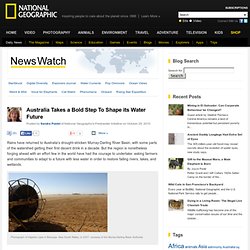

Stockman died of arsenic poisoning after bore water testing 'neglected' Source: The Australian AUTHORITIES may have ignored recommendations for bore water testing in the Northern Territory, leading to the death of a 17-year-old stockman and the arsenic poisoning of at least eight cattle station residents.

After Ben Witham died last month in an Adelaide hospital from arsenic poisoning, a police investigation found elevated levels of arsenic in the blood of long-term residents at Mount Bundy Station, leading Coroner Greg Cavanagh to call for the evacuation of the area. A 2008 bore water report by the NT Department of Natural Resources and Environment identified the area surrounding Mount Bundy Station as being at high risk of arsenic concentrations above Australian drinking water guidelines. The report said groundwater sampling for trace metals had been neglected in Darwin, and warned that arsenic contamination of bores would be unlikely to be detected by the government, "short of a significant poisoning cluster being detected by health authorities".
Is That a Banana in Your Water? This story is part of a National Geographic News series on global water issues. Banana peels are no longer just for composting or comedy shows: New science shows they can pull heavy metal contamination from river water. Metals such as lead and copper are introduced to waterways from a variety of sources, including agricultural runoff and industrial wastes. Once there, heavy metals can contaminate soils and pose health risks to humans and other species.
Lead is known to affect the brain and nervous system. Traditionally, water quality engineers have used silica, cellulose, and aluminum oxide to extract heavy metals from water, but these remediation strategies come with high price tags and potentially toxic side effects of their own. Australia Takes a Bold Step To Shape its Water Future – National Geographic News Watch. Rains have returned to Australia’s drought-stricken Murray-Darling River Basin, with some parts of the watershed getting their first decent drink in a decade.

But the region is nonetheless forging ahead with an effort few in the world have had the courage to undertake: asking farmers and communities to adapt to a future with less water in order to restore failing rivers, lakes, and wetlands. Photograph of irrigation pipe in Barooga, New South Wales, in 2007, courtesy of the Murray-Darling Basin Authority. (Read the 2009 National Geographic magazine article about drought in the Murray-Darling River Basin.) Photograph of the Murray River in 2004, courtesy of the Murray-Darling Basin Authority.